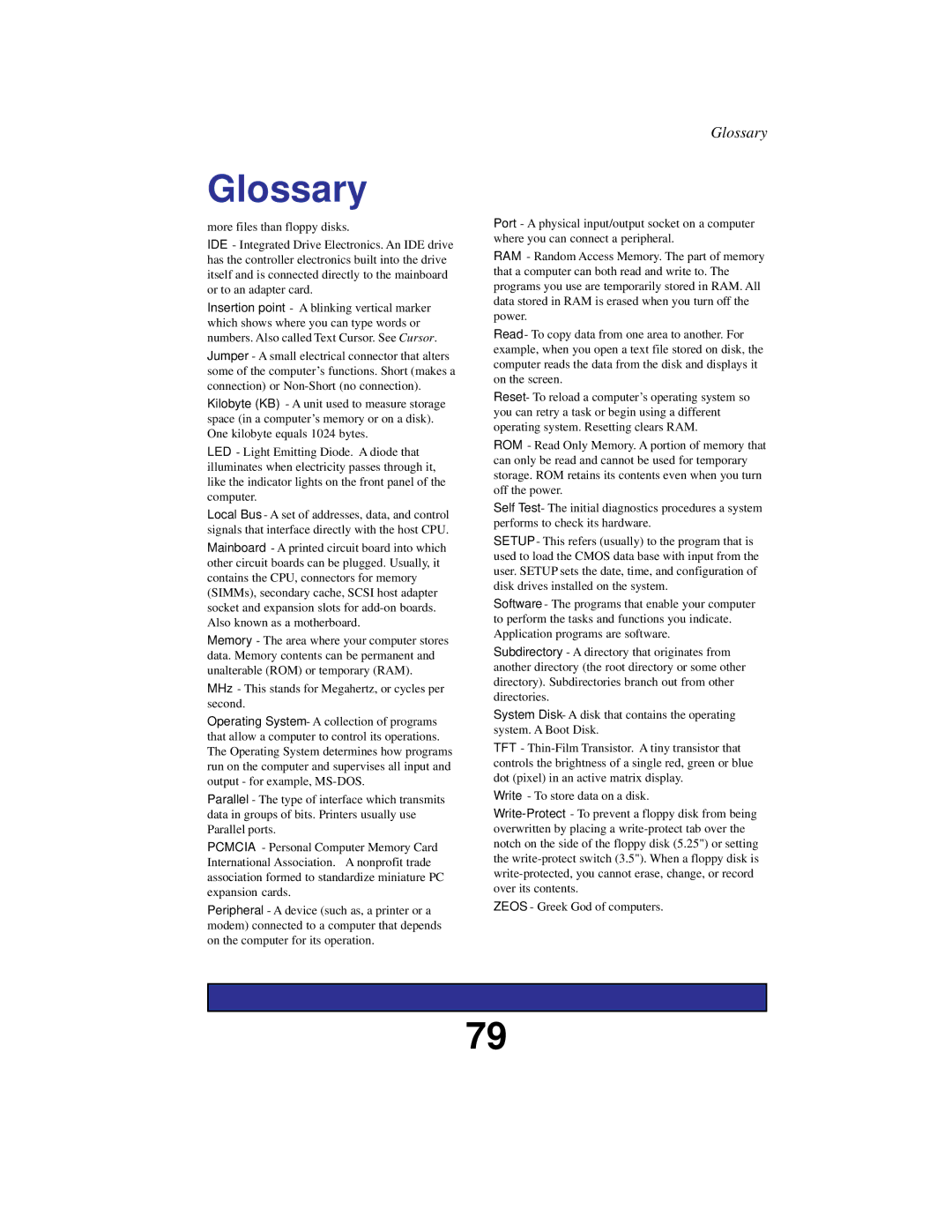Glossary
more files than floppy disks.
IDE - Integrated Drive Electronics. An IDE drive has the controller electronics built into the drive itself and is connected directly to the mainboard or to an adapter card.
Insertion point - A blinking vertical marker which shows where you can type words or numbers. Also called Text Cursor. See Cursor.
Jumper - A small electrical connector that alters some of the computer’s functions. Short (makes a connection) or
Kilobyte (KB) - A unit used to measure storage space (in a computer’s memory or on a disk). One kilobyte equals 1024 bytes.
LED - Light Emitting Diode. A diode that illuminates when electricity passes through it, like the indicator lights on the front panel of the computer.
Local Bus - A set of addresses, data, and control signals that interface directly with the host CPU.
Mainboard - A printed circuit board into which other circuit boards can be plugged. Usually, it contains the CPU, connectors for memory (SIMMs), secondary cache, SCSI host adapter socket and expansion slots for
Memory - The area where your computer stores data. Memory contents can be permanent and unalterable (ROM) or temporary (RAM).
MHz - This stands for Megahertz, or cycles per second.
Operating System - A collection of programs that allow a computer to control its operations. The Operating System determines how programs run on the computer and supervises all input and output - for example,
Parallel - The type of interface which transmits data in groups of bits. Printers usually use Parallel ports.
PCMCIA - Personal Computer Memory Card International Association. A nonprofit trade association formed to standardize miniature PC expansion cards.
Peripheral - A device (such as, a printer or a modem) connected to a computer that depends on the computer for its operation.
Glossary
Port - A physical input/output socket on a computer where you can connect a peripheral.
RAM - Random Access Memory. The part of memory that a computer can both read and write to. The programs you use are temporarily stored in RAM. All data stored in RAM is erased when you turn off the power.
Read - To copy data from one area to another. For example, when you open a text file stored on disk, the computer reads the data from the disk and displays it on the screen.
Reset - To reload a computer’s operating system so you can retry a task or begin using a different operating system. Resetting clears RAM.
ROM - Read Only Memory. A portion of memory that can only be read and cannot be used for temporary storage. ROM retains its contents even when you turn off the power.
Self Test - The initial diagnostics procedures a system performs to check its hardware.
SETUP - This refers (usually) to the program that is used to load the CMOS data base with input from the user. SETUP sets the date, time, and configuration of disk drives installed on the system.
Software - The programs that enable your computer to perform the tasks and functions you indicate. Application programs are software.
Subdirectory - A directory that originates from another directory (the root directory or some other directory). Subdirectories branch out from other directories.
System Disk - A disk that contains the operating system. A Boot Disk.
TFT -
Write - To store data on a disk.
ZEOS - Greek God of computers.
79
